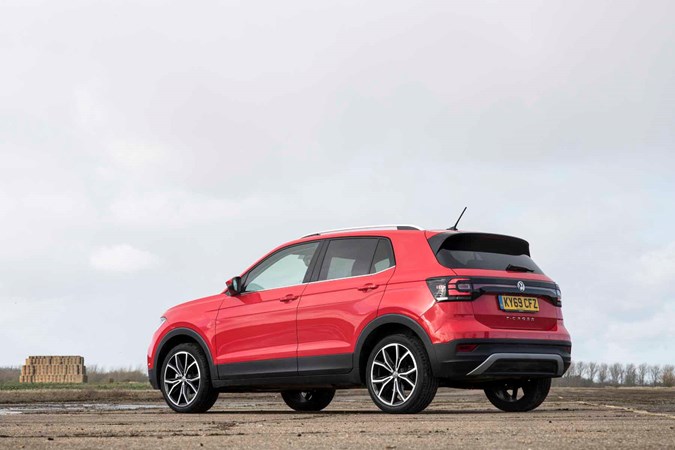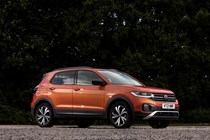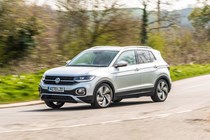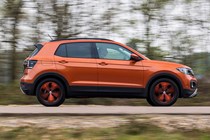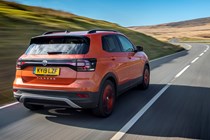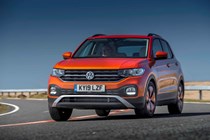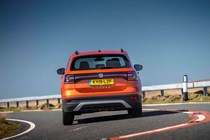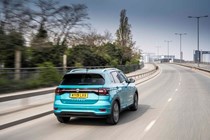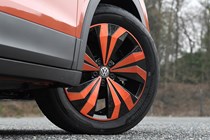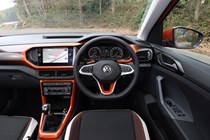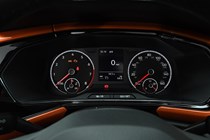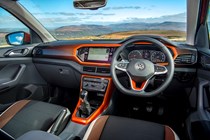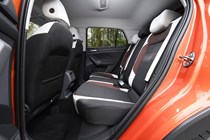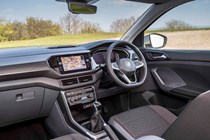
Volkswagen T-Cross long-term test
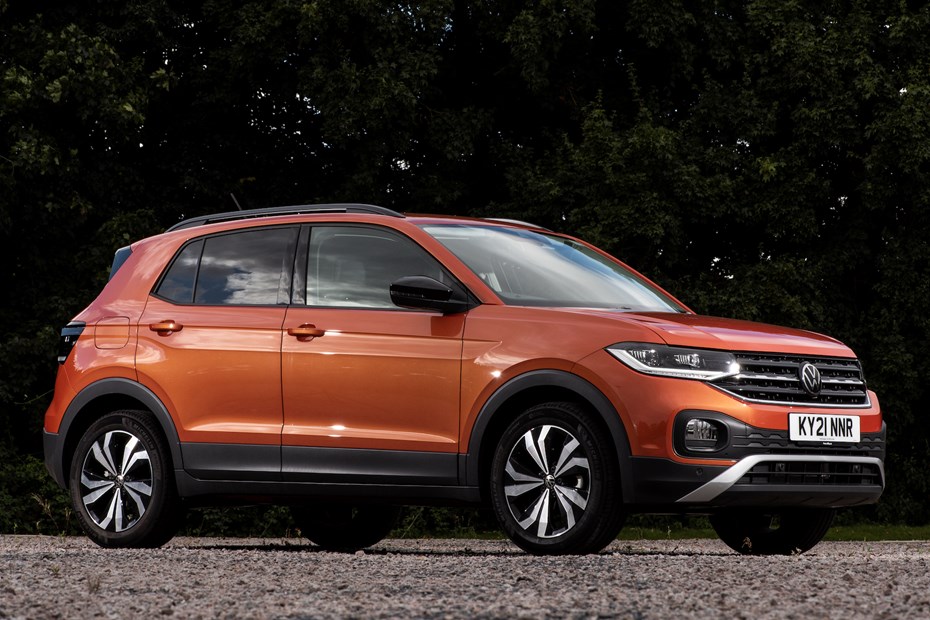
Update 1: Welcome
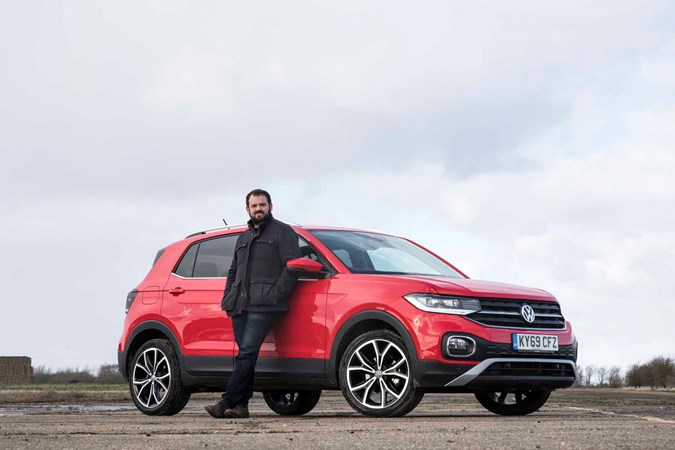
Motor Cycle News online editor and former Parkers associate editor, Gareth Evans runs a T-Cross for six months to see how it shapes up as a small SUV for all seasons.
Volkswagen’s SUV range naming strategy has taken a T-shaped turn of late, with this T-Cross joining the ranks alongside (in ascending order of size and price) the T-Roc, Tiguan, Tiguan Allspace and Touareg.
So that makes this the smallest of the bunch, based on the very same platform as the excellent but slightly too grown-up Polo, albeit with a taller ride height and chunkier styling to portray its off-roader intentions.
But being based on a Polo means there isn’t a lot more terrain-tackling talent apart from some marginally better ground clearance. It remains front-wheel drive (no 4×4 systems are available for this car) and goes without any sort of drive mode to alter the car’s characteristics to help with rougher surfaces.
But why, then, would you buy an SUV that doesn’t work off road? It’s all about the styling and the taller stance, you see: it’s certainly a more cheerful shape than the Polo, and the loftier seating position makes you feel more in control of the car and aware of your surroundings.
Is it practical?
Here’s another question I’m curious to answer. The T-Cross isn’t a huge car by any stretch of the imagination, but somehow its boot still measures 455 litres with the sliding rear bench as close to the front seats as possible. To put that into perspective, a Ford Focus only has 341 litres of luggage room and that’s an entire class of car larger than this VW. Impressive stuff.
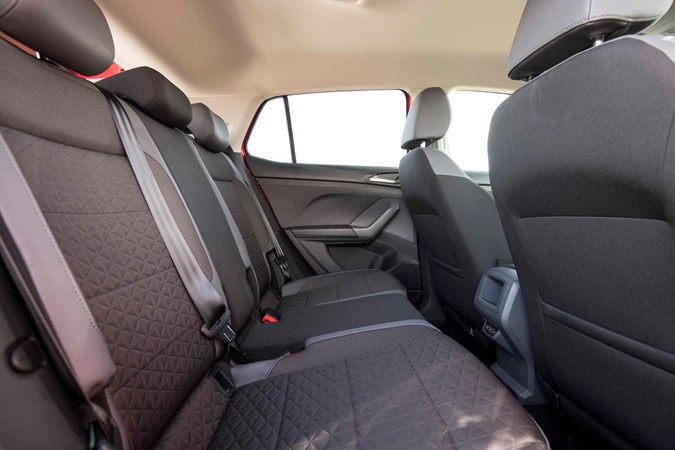
With the back seats folded there’s 1,281 litres to play with, which doesn’t mean a lot to anyone, but I’ve just moved house so I should be able to let you know exactly what fits and doesn’t, using the helpful unit of household items to illustrate my point.
VW T-Cross 1.0 TSI engine
I’m particularly curious about this T-Cross’s motor. At time of publication it’s the only one available in the range, albeit in a number of power outputs. This one’s got 115hp and 200Nm of torque, which translates to a 0-62mph time of 10.2 seconds. It’s bolted to a seven-speed semi-automatic gearbox called DSG, but there aren’t any paddleshifters to change gears myself. That’s taken care of by the gearlever instead.
I’m told by VW’s blurb to expect 44.7mpg on average, which will be impressive for a small engine in a car weighing nearly 1.3 tonnes. Let’s see how close I can get to that figure… hopefully very, given its fuel tank is a paltry 40 litres.
Volkswagen T-Cross SEL spec explored
This car costs £23,595 on the road, which is a lot of money for a Polo-sized vehicle. However, it does come rammed to the gunwales with kit. You can find out exactly what’s included in our full VW T-Cross review.
However, there are a couple of optional extras installed too. Those sharp-looking 18-inch wheels cost £440, while the posh 10.25-inch glass multimedia screen and associated features costs £375 extra. That seems a little too good to be true!
I’ve got the Winter Pack as well, which is £300, along with electric foldable door mirrors (£160), high-beam assist (£145) and a space-saver spare wheel that I hope I don’t have to use (£115).
I’ll go into more detail in the coming updates about what these options do and whether they’re worth it. In fact, over the next six months I’ll be trying to find out everything possible about the smallest VW SUV. Stay tuned for updates…
- Fuel economy: n/a
- Mileage: 0
Update 2: Performance and handling
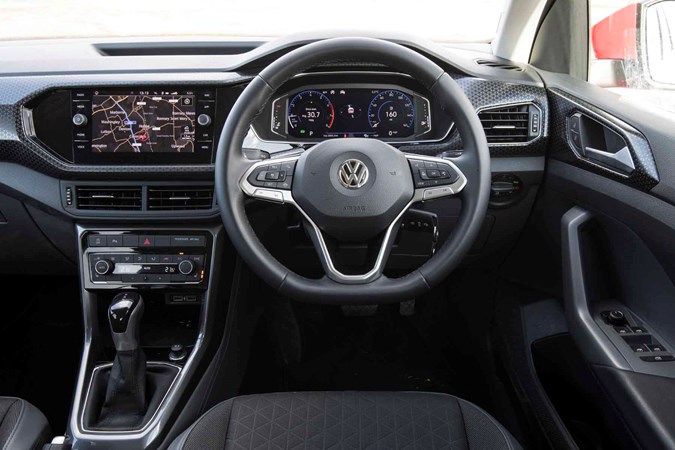
Once I’d found my feet with the T-Cross it was time to evaluate its driving talents. The little crossover’s taken me a few thousand miles to really get under the skin of, if I’m honest. Its 1.0-litre turbocharged petrol motor has a fair bit of character, with a pleasing thrum of an exhaust noise, but to start with I felt like it was held back significantly by the seven-speed DSG automatic gearbox.
The problem, of course, wasn’t the gearbox but with the driver. I started off being too impatient, and that’s not the way to drive this car. The symptoms were that the car would take a few moments to slot into forward (D) or reverse (R) gears, and would occasionally also hesitate when pulling away from a standstill.
You drive around this simply by anticipating the delay and pushing the throttle accordingly, so as to not over-rev in neutral and start making your way smoothly.
And in fairness, you can get around the gearbox hesitance when required by dropping the gearlever to S and engaging Sport mode.
There are no paddles behind the steering wheel like on larger cars with automatic ‘boxes, so to change gears manually you need to pull the gearlever forward or back.
But what’s brilliant about the engine and gearbox combination is something I wasn’t expecting: the ability to return over 40mpg on my commute. That’s very good for a petrol car and will be a welcome saving at the pumps compared with the thirsty car I ran before. Its claimed economy of 44.7mpg doesn’t seem in any way unrealistic.
Presumably it’s something to do with the T-Cross’s light weight – this car tips the scales at 1,281kg, which is less than I’d expect considering its dimensions. That kerb weight coupled with its tall stature does mean the wind can catch the car on a motorway at speed, causing driver corrections in the most extreme examples, as we’ve discovered several times over the past few weeks.
Slowing does solve this issue, however, so that’s the best advice. And it’s only a problem when the gusts are over 50mph, so it’s not exactly frequent.
Placed on the right road, you’re able to have a fair amount of fun in the T-Cross. It’s no sports car by any stretch, but its direct steering makes it feel agile and responsive. The extra bodyroll caused by the taller stance adds to the experience by making every direction change an event. It never feels like a large car, however. Through width restrictors you notice its lack of width compared with cars around you, and it’s an absolute dream to park thanks to simple controls and great visibility.
I’m not sure a car of this size really needs parking sensors and a reversing camera, but alas I’ve got that help to hand should I need it.
As a footnote to this, I’d like to try driving a T-Cross on smaller wheels. This one’s got optional 18-inchers where the standard car has 17s, with fatter tyres, and I think the ride quality would benefit from a little more compliance. It’s not rock-hard like a fast Audi, but there’s a spikiness to it that could be softened out a little.
- Mileage: 2,465
- Fuel economy: 41.2mpg
Update 3: Lockdown love affair
As you can imagine, the T-Cross hasn’t exactly done mega mileage since England’s lockdown began on 23 March. Instead it’s taken on the role of being a reliable and robust workhorse for my household, as my Wife was put onto the Government’s furlough scheme early on and we were both intent on spending extended periods behind closed doors, away from other people, isolating as effectively as we could against the spread of Coronavirus (COVID-19).
For the most part this meant nothing from the context of reviewing a car, because it simply sat there for days, or often weeks, at a time, between our occasional fretful trips to ‘new normal’ supermarkets to keep the larder stocked up.
I’m pleased to report this little VW did the job admirably, albeit with slightly less bootspace than I’d have preferred for larger shops. We often find ourselves putting shopping bags on the back seats or in the back passenger’s footwell to keep them secure, rather than use the flat, relatively shallow luggage area. That’s probably one to note if you’ve got kids: we haven’t, so take the use of the additional pair of perches for loading duties somewhat for granted.
There are hooks in that 455-litre boot, but the variable height floor is a little high to make it work in this configuration, and dropping the boot floor means reaching down for your shopping.
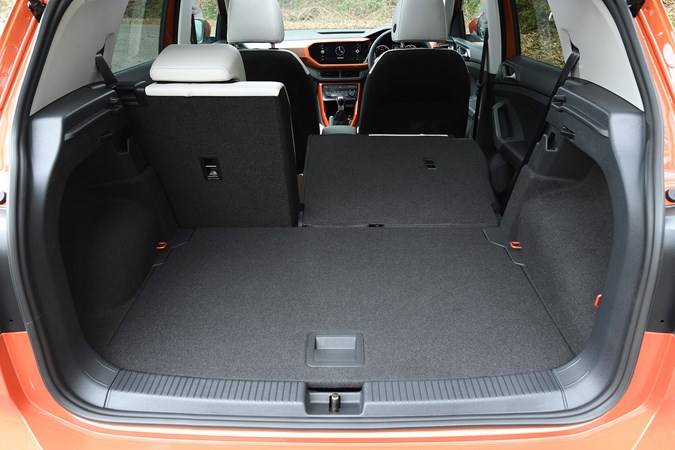
However, past that little foible, it’s a strong showing all around for the Polo-based small SUV. Its best attribute for these types of journeys is undoubtedly how simple and approachable the T-Cross is to drive. It wasn’t long ago that a car of this size was a rarity with an automatic gearbox, simply because of the economies of scale of fitting an expensive piece of equipment into a cheap car made prices less desirable. But now the market has changed. User behaviour has moved to monthly payments and finance schemes in a big way, and now car buyers can get more for their money compared with buying outright. Well, that’s the theory, anyway… check out our guide to car finance to learn about all this for yourself.
Still, I’m pleased with this tiniest limb of VW’s crossover family tree, because it’s a no-fuss approach to driving. Simply pull the gearlever down to D and away you go. There’s a slight lag as the transmission does its thing to engage first gear, but you get used to that quickly.
The other advantage to this seven-speed ‘DSG’ (Volkswagen’s named for a twin-clutch gearbox with quick, smooth and efficient gearchanges), is that I’ve noticed it’s seriously good on fuel. I’ll be the first to admit my driving has calmed down since lockdown began, because there simply doesn’t seem any point in rushing anywhere, and staying safe (or alert) away from burdening the NHS with a needless bump because of carelessness is the absolute last thing I want to get involved with.
So there I found myself, driving 15-20mph lower than normal on runs to the shop, and low and behold the fuel economy computer started showing me I was doing over 50 miles to each gallon of fuel, without even really trying. That’s incredible for a full-sized car with a 1.0-litre petrol engine.
It made me wonder quite how we’ve managed to get to this point, because the speed we travel during normal driving (I’m no boy racer these days at the best of times) is miles less efficient than moving slower. I could save significant cash by keeping this in mind when things begin to return to status quo. Why the rush to get everywhere, anyway?
- Mileage: 3,799
- Fuel economy: 50.1mpg
Update 4: Dream screen and the Volkswagen X-factor
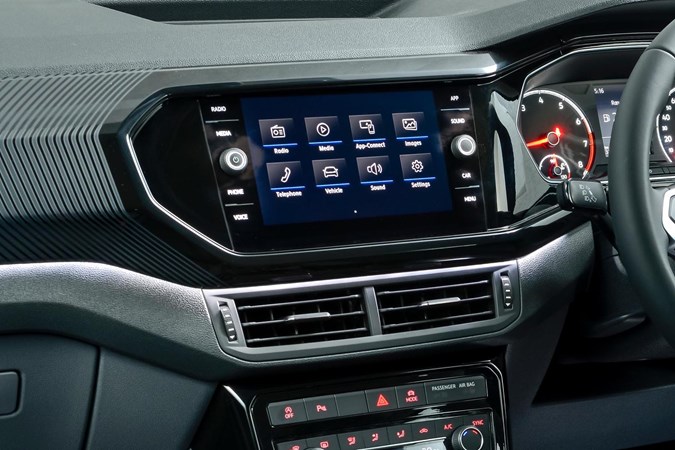
One feature this car benefits considerably from is the multimedia system. In SEL specification the T-Cross comes with the Discover Navigation system, which nets an 8.0-inch touchscreen system with an impressive array of features, including:
- DAB radio
- Full European sat-nav with map updates
- 2D/3D map view
- USB and Bluetooth connectivity
- Emergency calling function
- Steering wheel control buttons
And this car additionally has the nifty £375 extra Active Info Display for an instrument cluster (the bit where your speedo and rev counter live). This is a 10.25-inch screen rather than analogue dials, and as such can be configured to show information about sat-nav, car status, fuel and driver assistance systems in a variety of ways. All with the advantage of not having to take your eyes too far from the road.
I’ve begun setting the car up so I’ve got zoomed-in navigation instructions between rev counter and speedo, with a far wider view displaying on the main 8.0-inch touchscreen. This gives me the combination of an overview and specific detail, which feels like a good balance. I love using the screen because it’s a pleasingly solid glass finish, making it feel like a high-grade smart device. Shame about the fingerprints, but it’s a small price to pay…
To begin with I was using Android Auto a considerable amount, and very much enjoy its integration with VW’s systems. Voice control through Google Assistant is an extremely handy tool once you get to know it.
However, my smartphone’s charging port went faulty early on with the car, so I’m back using Bluetooth to stream Spotify, and VW’s mapping systems rather than Google’s or Waze’s. It works perfectly well apart from one tiny thing, that becomes annoyingly fiddly when you’re in a rush. It’s a classic complaint for all VW Group vehicles, and has been for a long time. The sat-nav menu defaults to European postcodes, which are numeric. This means an irritating extra step in order to input your destination. Not the end of the world, but for the sake of a few lines of code it seems mean not to have fixed this considering the sheer number of cars Volkswagen sells on these shores.
But then I’m talking about a matter of seconds here, so perhaps this quibble is more indicative of how many things the world’s largest car company has got right.
And here’s another thing that’s sprang to my attention when slowly navigating supermarket car parks of recent months. This car catches peoples’ eyes. I’m not sure what it is about it – perhaps the larger, racier looking 18-inch wheels are a factor, or maybe it’s the classic cliché: the VW badge. Or maybe the Flash Red paint, which is a £275 option. Either way, gazes linger unmistakably on this machine as I roll by, and they don’t appear to be angry ones. They’re always happy faces.
This wasn’t something I noticed in the almost-identical Skoda Karoq I ran before this car. That was red and had big wheels too. For now I’m going to chalk it up to the VW X-factor… until that is I’m allowed to go and talk to the general public about their opinions on the T-Cross. Sure it’s a great little car, but clearly I’m missing something…
- Mileage: 4,564
- Fuel consumption: 49.4mpg
Update 5: Destination Devon
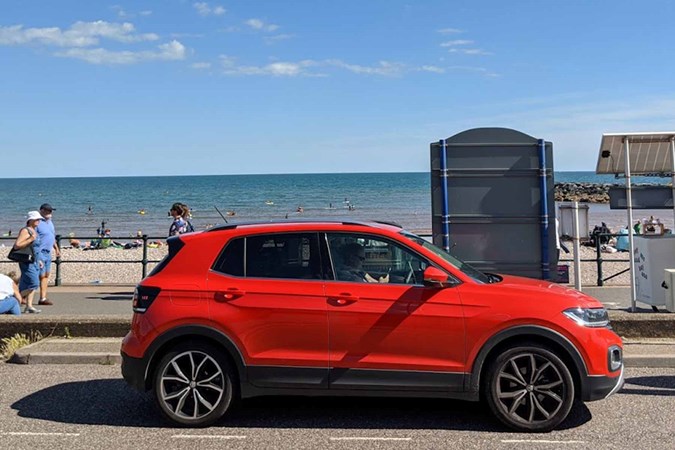
There’s no better way to get properly acquainted with a car than to take it on a long road trip, but I think it’s pretty obvious that hasn’t been possible for the best part of of 2020. However, as restrictions began to lift and travel in-country started to become a realistic proposition, I jumped onto a booking website and secured my wife and I a weekend break down in Sidmouth, Devon.
From my home in East Northamptonshire, that’s a good 460-mile round trip in a car that I hadn’t used for anything more than a handful of miles to supermarkets and suchlike. The ideal chance to see what it’s like on a run. Before setting off, I made sure I hit the button on the steering wheel that opens the driver assistance menu on the dash.
I think this is an essential move on the 2020 T-Cross, because it allows you to turn off the active lane-keeping tech that interferes with the steering constantly. The car defaults to having this switched on every time you put the key in the ignition. I wouldn’t mind that, except the way VW has configured it is so sensitive that it feels like it’s working nearly all of the time. Because of that, it’s more tiring than necessary, which in itself is a safety issue on longer drives. I’m confident in my ability to remain in my lane, so switching this off makes sense.
Adaptive cruise control impressions
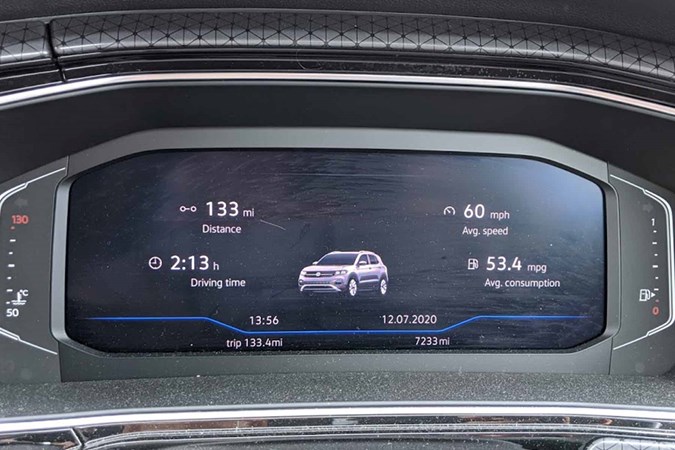
The adaptive cruise control (which keeps you a set distance from the car in front up to your chosen speed) is something that makes more sense to me, however – particularly for those pesky 50mph average speed camera-laden roadworks that litter our highways. We hit some serious traffic on the M5 where it joins the M4, and it’s far more restful than operating the car yourself in that situation. You do still need to stay alert, but it lightens the load.
Upon arrival in Sidmouth some 4.5 hours later, I was tired and ready to sit down with a drink and reflect on the drive. The T-Cross’s automatic gearbox is an undoubted ally due to its ease of use and smooth changes, but its small luggage capacity with the seats slid all the way back to cater for possible passengers (who slides the rear bench anyway?) meant fitting all our cases was a squeeze.
But I also noticed that it’s a noisy car to travel distance in. There’s a specific reason why this is the case: the optional larger wheels matched with the T-Cross’s rear suspension, which isn’t as sophisticated as other VW cars’ setups. This makes for quite a racket, but you only notice this when you stop driving after a long stint.
Long-distance comfort: lacking
In fact, that same suspension-wheel combo is a reason the ride isn’t as comfortable as it could be. The way it controls the rear wheels’ vertical movement means jolts are sent right through the vehicle unexpectedly. On the wrong road it can be quite unsettling.
But that said, the T-Cross was an admirable companion for this journey, and I was particularly glad to have the advantage of Android Auto with Google Maps integration. I think this is the single best navigation solution on the market, and it’s a joy to use on that big glass touchscreen.
And one final note on fuel economy. Despite its relatively small fuel tank, the T-Cross needed one fill to get me to Devon and back again. I remain very impressed by this motor.
- Mileage: 5,212
- Fuel consumption: 49.7mpg
Update 6: Conclusion
Gareth bids a fond-ish farewell to his small SUV, but would he spend his own cash on one?
It’s fair to say my time with the Vollkswagen T-Cross wasn’t as I’d expected when I took delivery back in the days before the Covid-19 pandemic. It sat still for vast periods of time, and was used for just one long trip to Devon as restrictions lifted enough to leave my county.
The positive points
So what did I learn? Plenty, despite my unusual use of the car compared with regular test schedules. As is often the case with VW products, I was really impressed with the multimedia kit on offer on ‘my’ T-Cross. The glass screen and inclusion of Android Auto and some upgraded speakers meant I had everything I needed – sat-nav, streaming music, voice control. There isn’t much out there I’d want to add, even from the most impressively appointed modern vehicle.
…and the not-so positive
There are things I’d do without, though. The driver-assistance technology, which helps you steer, brakes for you and enables adaptive cruise control, was something I never gelled with. It was constantly trying to steer me into positions I didn’t want to be in, so I felt like I was fighting it for the whole six months rather than learning to live with it.
Sure, you can switch it off easily with a few button pushes on the hugely useful multifunction steering wheel, but every time you switch the T-Cross off it’ll turn back on again. Fine for longer journeys, but infuriating when you’re hopping in and out for shorter trips.
And while the 1.0-litre engine is an excellent thing for a car of this size, providing punch and properly impressive economy to boot, I don’t need or want the extra expense of an automatic gearbox. Furthermore, I found this one hesitant unless you use Sport mode, which makes the throttle too sharp to be a pleasant drive. Give me a six-speed manual and the £1500 saving in my back pocket please… along with the slightly better fuel economy and CO2 emissions.
T-Cross gets the nod over Skoda alternative
In fact, all that time locked inside my house did give me ample time to consider whether I’d put my own money towards this small, relatively cheap Volkswagen SUV. If I were in the market, I’d have to consider it. Usually I’d say pick the Skoda equivalent, the Kamiq, but you’ll only save yourself £745, or a few more quid on the monthly PCP, and for the difference there is a noticeable hike in build quality with the VW. Plus I think it looks better – or at least certainly more grown up.
But the elephant in the room was something I mentioned in my first update: I wouldn’t pick it over the equivalent Volkswagen Polo – the car on which the T-Cross is based. I prefer a small hatch to an SUV every day of the week, as it’s less compromised for my lifestyle, being smaller, more economical and nicer to drive. Its boot isn’t even much smaller. That’s where my dosh would go.
- Mileage: 6,212
- Fuel economy: 48.2mpg
